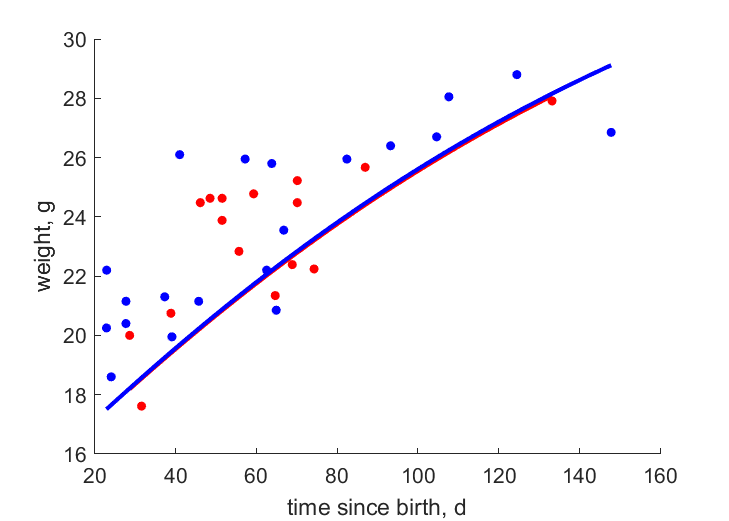Predictions & Data for this entry
| Model: stx | climate: Am | migrate: TW | phylum: |
| COMPLETE = 2.5 | ecozone: TPa | food: bxM, xiHs, xiHn, xiCii | class: |
| MRE = 0.055 | habitat: 0iTf, 0iTi | gender: Dg | order: |
| SMSE = 0.006 | embryo: Tv | reprod: O | family: |
Zero-variate data
| Data | Observed | Predicted | (RE) | Unit | Description | Reference |
|---|---|---|---|---|---|---|
| tg | 183 | 179.8 | (0.01734) | d | gestation time | guess |
| tx | 50 | 51.46 | (0.02914) | d | time since birth at weaning | guess |
| tp | 183 | 183.6 | (0.003173) | d | time since birth at puberty female | Thom1984 |
| tpm | 213.5 | 213.7 | (0.001002) | d | time since birth at puberty female | Thom1984 |
| am | 7957 | 7877 | (0.01005) | d | life span | guess |
| Wwb | 15.5 | 18.05 | (0.1644) | g | wet weight at birth | Thom1984 |
| Wwi | 35 | 37.2 | (0.06274) | g | ultimate wet weight | Thom1984 |
| Wwim | 35 | 37.34 | (0.06683) | g | ultimate wet weight for males | Thom1984 |
| Ri | 0.005479 | 0.005413 | (0.01205) | #/d | maximum reprod rate | Thom1984 |
Uni- and bivariate data
| Data | Figure | Independent variable | Dependent variable | (RE) | Reference |
|---|---|---|---|---|---|
| tW_f |   | time since birth | weight | (0.08482) | Thom1984 |
| tW_m |   | time since birth | weight | (0.09239) | Thom1984 |
Pseudo-data at Tref = 20°C
| Data | Generalised animal | Micropteropus pusillus | Unit | Description |
|---|---|---|---|---|
| v | 0.02 | 0.03138 | cm/d | energy conductance |
| kap | 0.8 | 0.5497 | - | allocation fraction to soma |
| kap_R | 0.95 | 0.95 | - | reproduction efficiency |
| p_M | 18 | 107.7 | J/d.cm^3 | vol-spec som maint |
| k_J | 0.002 | 0.002 | 1/d | maturity maint rate coefficient |
| kap_G | 0.8 | 0.7984 | - | growth efficiency |
| t_0 | 0 | 132.2 | d | time at start development |
Discussion
- Males are assumed to differ from females by {p_Am} and E_Hp only
Facts
- Males tend to be smaller than females (Ref: Wiki)
Bibliography